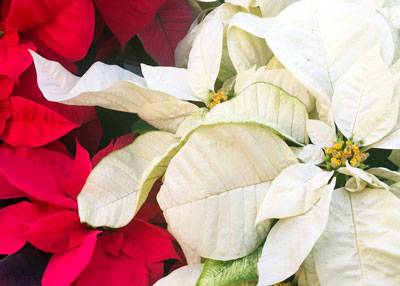What to Do With Your Poinsettia Now

Photo: Traditional red poinsettia stands in stark contrast to the snow-white type. Take good care of them and they can reward you for months.
I know we addressed poinsettias here a couple of weeks ago, but apparently not everyone saw it. What I’m being asked everywhere I’ve turned these past few days is, “What can I do with my poinsettia once Christmas has passed?” Here are your options.
• Enjoy it as long as you can by keeping it uniformly moist at all times. Once you let a poinsettia wilt, even if it’s only one time, it will go downhill really quickly. Properly watered and kept in a cool, bright spot indoors, it’s not uncommon for a poinsettia to remain handsome clear up until Easter.
• As soon as it has finished its run of good looks, you have a choice. You can either prune it back by 20 or 25 percent and repot it into the next larger pot size, or you can discard it with the knowledge that there will be lovely new poinsettias next Christmas.
The thing that most people don’t realize is how really quickly poinsettias grow and how large they can become in just one growing season. If you give them ample root room, either by repotting them every 4 to 6 weeks or by setting them out into the ground (in frost-free tropical areas only!), they can grow to 8 or 10 feet tall in just one summer.
My recommendation, since most of us don’t have room for plants of that size, would be to repot the plant to progressively larger pots in March and again in May or early June. You should be able to hold it in a pot that’s 20 or 24 inches in diameter. Pinch the growing tips out periodically to keep it more compact, and don’t let it dry out.
Beginning October 1 your plant must be given 14 hours of uninterrupted darkness at night and 10 hours of very bright sunshine in daytime. That will allow the plant to produce a flowering hormone that initiates blooming.
Note: This artificial dark period of 14 hours daily is only administered October and November. By Thanksgiving your plant should be showing nice color on its developing bracts.
